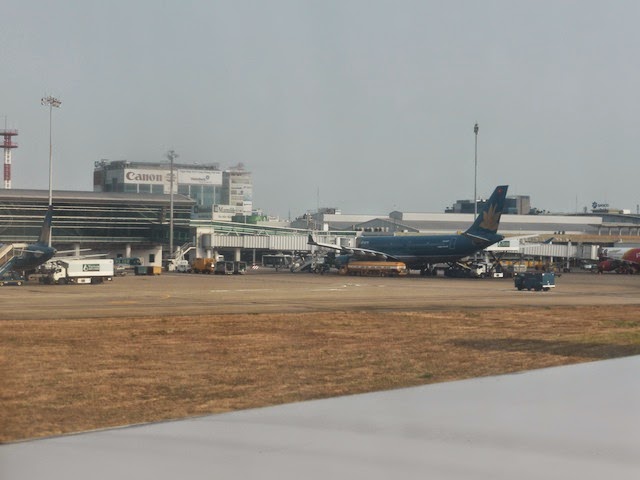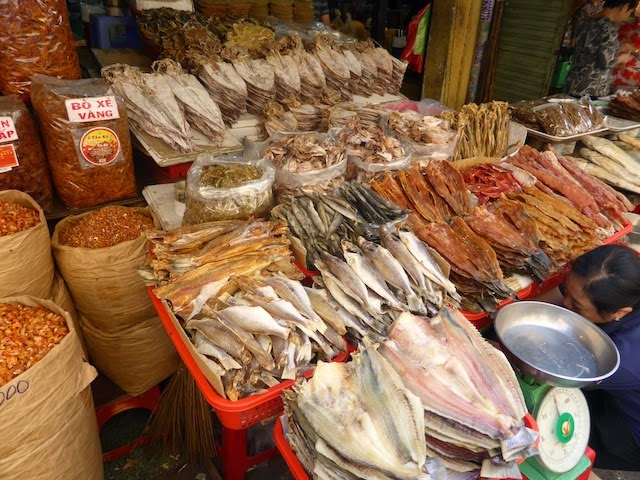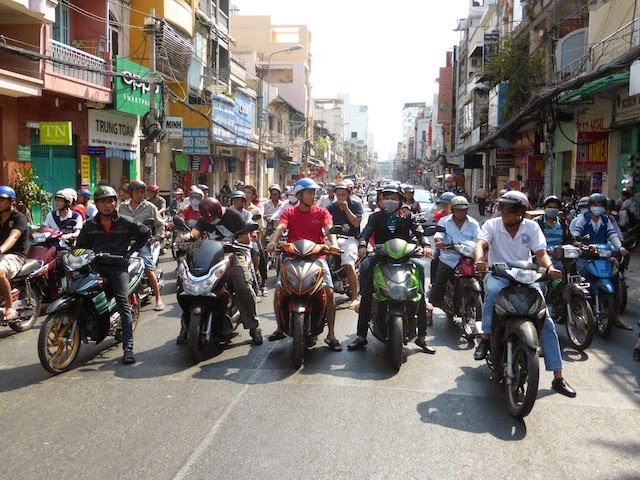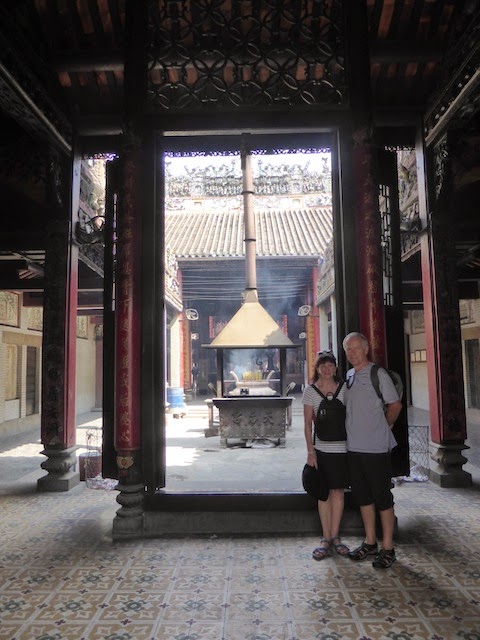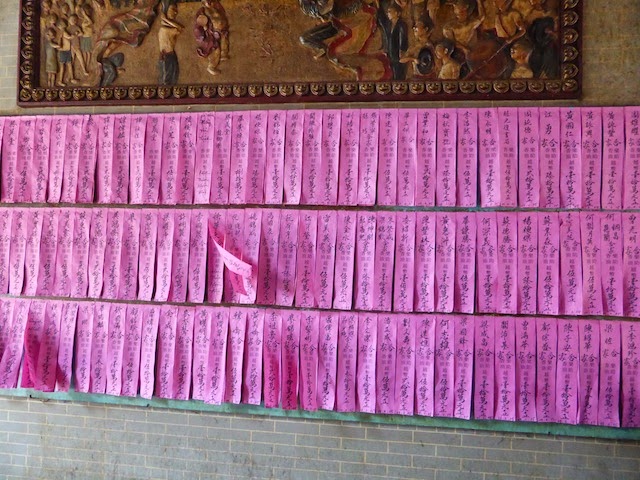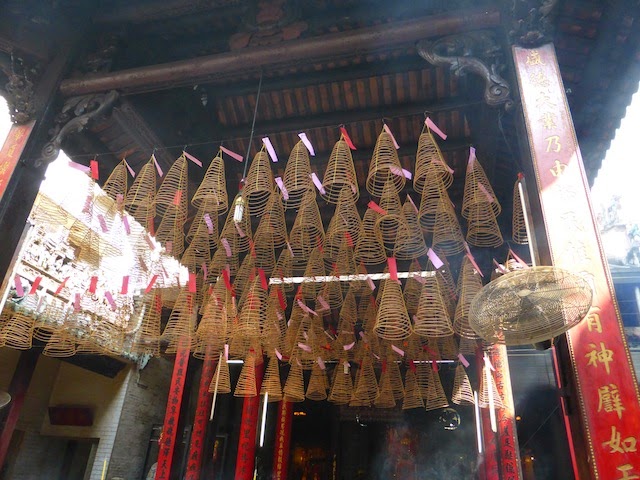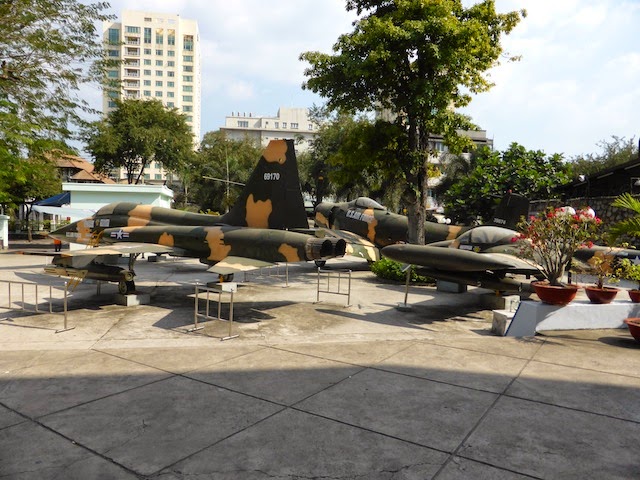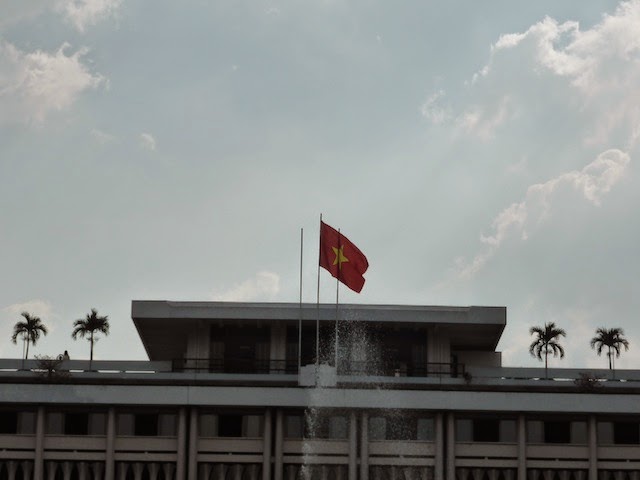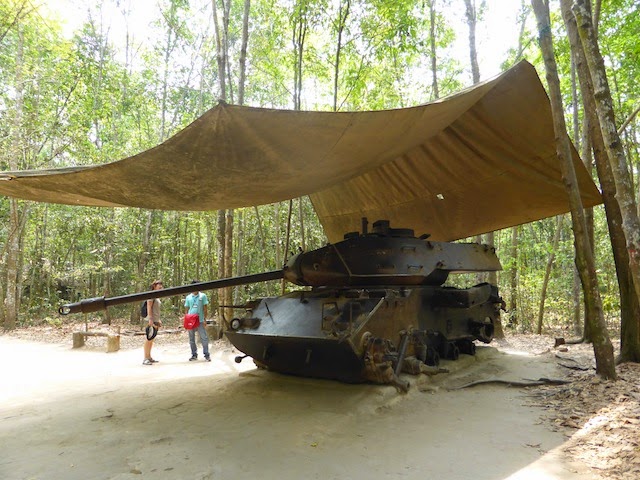Sunday, March 1st
It was Sunday morning, but we were still having breakfast by 7:30am so we'd be ready to be collected by Lee the guide and Thi the driver by 8:30am. As the itinerary suggested, they had a very full day of activities planned for us, and it wasn't exaggerating. The view from the hotel window promised a nice day, but and air conditioned room hides the truth about the heat and humidity below.
Our first stop was the Chinese markets about 20 minutes away. The street outside was crowded with motor bikes, and cars dropping off customers.
Inside there was a courtyard with a fountain and shrine to Buddha (presumably).
And of course an incredible array of food and goods of every kind. These are varieties of dried shrimp - I didn't know there were this many, and all imported from China, apparently.
Dried fish anyone?
Back on the streets we noticed cables everywhere. Now I've seen many photographs of cables in so-called "third world" countries, and the usual joke about the local "NBN". Well, of course it's all true, but given the use of mobile phones here you have to wonder when these cables will all be cut down. High speed broadband, anyone?
Prue is obsessed with the motor bikes, and the variety of stuff they carry on them. We're both obsessed with them whenever we have to cross a road while they wait impatiently for the lights to change.
And when the lights do change, they're off, who knows where?
We were on foot heading to a neighbourhood Chinese temple. Apparently temples are maintained by communities, whereas pagodas are maintained by the monks.
The entire temple was constructed from material brought from China, and in the middle was a fire burning incense.
And along the walls were coloured paper tickets showing contributions from sponsors and supporters.
Up above was more incense, this time in spiral formation which apparently takes 15 days to completely burn.
Finally, at the back are various representations of the local spirit Queen, and her helpers.
We couldn't help seeing the similarities with Christian religions, and especially Catholicism.
From the temple, we got back on our air conditioned car, by now a haven from the heat, and found our way (well, we were lost, but he driver knew the way) to the Fico pharmaceutical company's Herbal Museum.
This building was originally in Hanoi but was transported to Saigon to support the company's collection of traditional herbal medicine.
The building itself was lovely, and from the top (4th) floor there was a nice view of another pagoda (or is hat a temple?).
And looking down from the same floor you could see various balconies and stairways which were consistent with the building's 19th century heritage.
On the third floor, a nest of bees had taken up residence on the limb of a frangipani tree - they say the honey from these bees is divine.
Meanwhile, the company's guide showed us the hundreds of different herbs classified by two well known 16th and 19th century herbal "doctors".
By now it was lunch time and we were taken to a nearby restaurant for our pre-arranged fixed menu lunch. Prue had coconut juice, I had beer.
Refreshed, and relaxed, our next stop was the famous War Remnants Museum. This very interesting and confronting museum is set inside the former (USIS) USA Information Service, a not so covert propaganda and spying agency during the Cold War, and perhaps even today.
The museum is probably the most visited tourist destination in Saigon, and it's so confronting that we wondered whether many Americans ever visited it. I'm sure they do, but they would need to do their research so they're not taken by surprise.
History is written by the victors, but in this case it's probably very accurate.
While the interior contains large collections of photographs, documents and descriptions of the various Vietnam wars from 1945 through to 1975, outside has an interesting collection of 1960's and 1970's American military hardware.
Just down the road, and occupying a large block in the middle of town, is the Reconciliation Palace, formerly the Presidential Palace. The Palace was the centre of power in Saigon for almost a century, although it was destroyed and rebuilt in the 1960's. It's most famous for being marking the end of the Vietnam War in 1975 when two NLF tanks smashed down the front gates.
And the tank crews raised the North Vietnamsee flag over the palace where it still flies today.
You can visit most parts of the palace, and it's still used for ceremonial purposes. However, the capital of Vietnam is now Hanoi.
Most parts of the palace are preserved in their 1975 condition, including the various (1970's, state-of-the-art) telephones.
The president's relaxation/games room - Andy Warhol would be proud.
Information about the taking of the palace by the two tank crew.
A state-of-the-art "communications" (ie. telex) room.
And the favourite car of one of the last presidents to occupy the palace. Here's even a bunker in the basement, and the last days of the Nazi Party come to mind.
With a rather full day's sight-seeing coming to an end, we visited the French built Catholic Cathedral (also called Notre Dame), but couldn't go inside because Mass was being celebrated.
Across the road we went into the century old Post Office, where stamps were still being sold, but the telephone booths had been converted to ATMs (note the clock showing the time in Canberra - no daylight saving though).
We walked into the nearby "fashionable" section of Saigon to see the Continental Hotel where Graeme Green apparently wrote the Quiet American.
And just a bit further on, the Opera House (yet another scaled down version of the Paris Opera?).
We really felt like a G&T at the Cosmo, but took note of the nearby Rex Hotel for the following day. Instead, we went back to the hotel for a very well earned rest, cleaned up, and eventually found a nice outdoor restaurant for a beer and (yet more) noodles.



